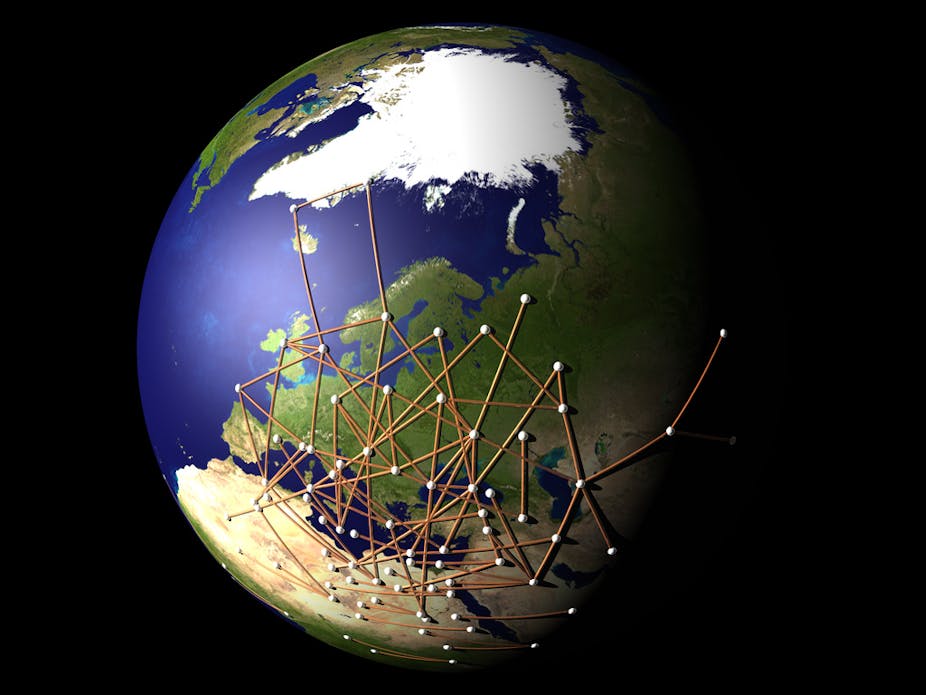Anyone observing the climate change debate from Australia might think the world is moving away from carbon trading schemes. That would be understandable, but wrong.
International carbon markets exist, they are working and even more markets are planned.
Politics shapes these markets, and politicians seeking to accommodate vested interests often weaken them. Even so, a patchwork quilt of carbon markets is emerging.
The Federal Government has announced it will seek to link Australia’s carbon trading scheme to international markets. That is the right approach.
The mother of all carbon trading schemes is the European Union Emission Trading Scheme, established in 2005. Current prices in the scheme are low – €12 per tonne of CO₂ emitted. This is due to the fragile European economy, too many emissions permits, and a drop in emissions caused by an EU push to boost energy efficiency.
Nevertheless, confidence in the scheme among participants is rising as it leads to more emissions cuts each year, according to a Reuters’ survey. Airlines will join in 2012, and other sectors in Phase 3 after 2013, when analysts forecast the price will reach €23 a tonne.
While the price volatility will worry some businesses, this is normal for such markets and actually reflects efficient pricing.
New Zealand has introduced an emissions trading scheme (ETS) as its main mechanism for reducing carbon emissions by up to 20% by 2020. Australian and New Zealand officials are already discussing how the countries’ schemes could be linked.
Ten states of the USA have signed up to a mandatory cap and trade scheme that seeks a 10% reduction in emissions from power plants by 2018.
Economically, the scheme seems to be working as designed, but the politics are delicate. Permit prices have recently been as low as US$2 a tonne and some states such as New Jersey have threatened to withdraw.
The scheme will be reviewed in 2012 and its design features are likely to be substantially tightened.
The other major existing market is the Clean Development Mechanism (CDM), established under the 1997 Kyoto Protocol. The CDM enables countries to move toward their emissions reduction targets by investing in emissions reduction projects in developing economies.
This market remains under a credibility cloud largely due to criticisms of the test for valid initiatives and the integrity of some projects. In recent years, developed countries have moved to restrict the type of CDM projects from which they accept credits.
Even so, between 2001 and the end of the Kyoto commitment period in 2012, the CDM is expected to have reduced emissions by the equivalent of around 1.5 billion tonnes of CO₂.
Many more carbon markets are planned. California intends to introduce the USA’s first economy-wide carbon market next year in an effort to reduce the state’s carbon emissions to 1990 levels by 2020. Prices are likely to start at around $US20 a tonne.
The Governor and the EU have discussed how the schemes might be linked, recognising they do not have to be identical, just compatible.
In South Korea there is bipartisan political support to introduce an ETS by 2015. Japan has been testing voluntary emissions trading schemes and India has put a tax on coal that has the effect of putting a price on carbon emissions produced from coal.
Last but far from least, China is proposing to introduce pilot emissions trading schemes across six provinces by 2013.
The expansion of market schemes is not surprising. They work. The recent Reuters survey of the EU scheme reported that half of participants – the highest level to date over six surveys – found the scheme to be the most cost-effective instrument for reducing emissions in the EU.
Australia’s Productivity Commission found ETS to be more cost-effective than alternatives, including feed-in tariffs and rebates.
A Grattan Institute report published this year showed that not only did market mechanisms reduce emissions at a greater speed and scale than mechanisms such as grant schemes and rebates, they also produce more innovation than other approaches.
Linking domestic carbon markets internationally will allow the buying and selling of emissions permits and offset credits between these markets. The principle of comparative advantage will mean that the lowest-cost ways to reduce emissions will be implemented first, regardless of where in the world they might be.
In addition, international trading will help reduce the risk of carbon leakage and encourage developing economies to adopt climate change policies. Linking Australia’s ETS with international carbon markets is likely to mean we meet our emissions reduction targets at lower cost than would be achieved if we traded only within our own scheme.
From 2015, liable companies in Australia will be able to buy permits from credible international carbon markets or emissions trading schemes in other countries.
International linkage will be complex and most countries will adopt this approach carefully to avoid risks to the integrity of their markets.
So, while a single, global market is unlikely to emerge in the near future, a climate system is taking shape. Most likely it will be based on individual country commitments, with bi-lateral and regional linkages between compatible schemes.
Australia is well-positioned to learn from the mistakes of these schemes in the past and become an important player in a global carbon trading system that is being built from the bottom up.

